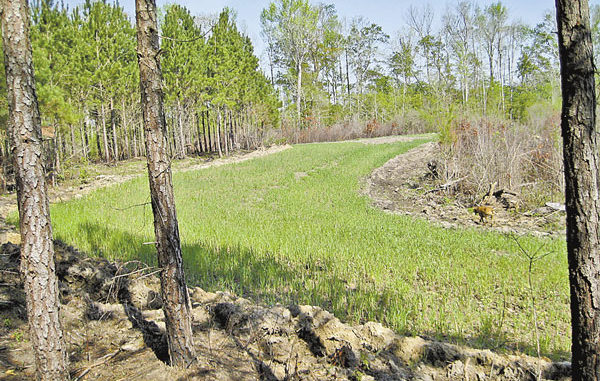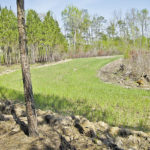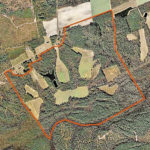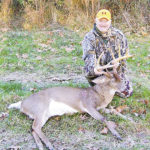
A deer hunter’s dream is to have the perfect property littered with lush, natural food sources and covered with trophy bucks.
Men in waders having recurrent dreams of ducks blackening the skies routinely look for acres of impounded grain fields in the path of migrating waterfowl.
Many other hunters look for tracts loaded with all game species to satisfy every fancy they may have.
For most, the search for that perfect hunting property is an ongoing saga. There is always another good property out there waiting to be discovered that’s overflowing with mature bucks. Knowing what to look for and which resources to use will help you land a successful tract for the upcoming season.
While development continues to gobble up tracts once treasured as pristine hunting grounds, the majority of the Carolinas continues to remain rural in forest and agricultural production and is highly conducive to growing and maintaining healthy wildlife populations.
Unfortunately for many landowners, transferring ownership of a portion of their total holdings is becoming a reality. Land listings across the state are on the rise, with “For Sale” signs littering the highways.
The slumbering economy has disinterested land developers and speculators, finally moderating land prices. The combination of these factors has produced many affordable prime hunting properties and more are becoming available everyday.
Steve Dana, a lifetime sportsman and owner/operator of Farms and Land Realty in Southern Pines, N.C., has spent the past 14 years connecting avid outdoorsmen with sellers of prime hunting, farming, and forestry tracts. Over the years, his personal and professional outdoor interests have honed his ability to recognize quality, game-rich tracts throughout the Carolinas and Virginia.
In fact, Dana started the land-acquisition program for the N.C. State chapter of the National Wild Turkey Federation (NWTF) more than 10 years ago to promote the proliferation of the wild turkey throughout the state of North Carolina. His efforts at the NWTF have enrolled thousands of acres of prime turkey habitat.
“The majority of realty companies out there have residential or commercial interests,” Dana said. “We have collaborated with a network of realtors, landowners, and property managers throughout the Carolinas to develop a single resource with an emphasis on recreational use lands. We recognize the components of a good hunting tract and make these parcels available for prospective buyers with a strong interest in its recreational value.”
The many improvements to the federal and state highway systems have increased access to many tracts once considered too far away from home. Within a few hours’ drive at the posted speed limit, many available hunting tracts are more accessible today than ever before. With the help of the internet and the many enthusiasts out there, looking and finding available tracts is becoming a less painful process than before.
The recipe for a perfect deer tract should contain an annual, rich food source, adequate cover, and low hunting pressure. Game species, especially deer, are suckers for solid, protected food sources, and food-plot cultivation should be part of any deer-management regime. Tracts partly covered in fields or open areas should be identified and targeted, but areas lacking these open fields are not deal-killers either. If no fields are present within the property boundaries, fields can be created, but the ground conditions, soil type, and wetness of fully wooded tracts should be investigated to see if the land is suitable for reliable food-plot production.
The ideal tract for deer hunting can be of almost any size. Although, large parcels — 5,000 to 10,000 acres — can be managed for superior deer hunting, only a few individuals and corporations can fund this type of endeavor. Large, contiguous tracts are a rarity throughout the Carolinas, and very few become available for purchase. The majority of tracts available are generally from 20 to 350 acres, but the actual size can be less important. When less than several thousand acres in size, quality plays a greater role than quantity.
“Sometimes, the best hunting tracts out there are less than 100 acres in size,” Dana said.
Small tracts with the perfect combination of ideal land cover, natural or cultivated foods available and proximity to other tracts are ideal, with proximity among the most-important factor when evaluating a prime tract. Deer and other wildlife do not recognize property boundaries.
With the exception of the mating season, deer have relatively small home ranges throughout the year. They will maintain their zip code as long as food remains plentiful and the level of human disturbance remains brief. As mating season begins and fall foods begin to recede, the herd will gravitate towards solid food sources.
“Small tracts adjacent to large, undisturbed lands with little hunting pressure can be game magnets with the right food-plot program or active agriculture in place,” Dana said.
However, the hunting pressure and harvesting guidelines on adjacent and neighboring properties should be investigated before making land acquisitions as well. Although minor changes in hunting philosophies can be insignificant among neighboring tracts, major discrepancies will cause continued problems and dissatisfaction. Sometimes, tracts can not be too large to escape conflicting harvesting guidelines and hunting methods.
The perfect situation is to find tracts with little to no hunting pressure or at least intensively managed lands with sound management guidelines in place.
“Frequently, tracts adjacent to suburban areas just outside of the city limits are eliminated as eligible hunting tracts for many prospective landowners, but these tracts often are gold mines for huge bucks and flocks of old gobblers,” Dana said.
Tracts close to town are protected woodlots with little to no hunting pressure, and many suburban areas have natural corridors interconnected to large chunks of habitat. Wildlife on these tracts will be less weary of human scent and unnatural noises. However, in order to draw wildlife from the expansive suburban complexes, a solid system of lush food plots is required throughout the year. You don’t want trophy bucks spending their evenings munching on the neighbor’s tender landscaping.
Sometimes, the best hunting tract is the neighboring parcel joining an existing piece already under ownership that comes up for sale unexpectedly. The more acres managed and protected as a single management unit will improve long-term success. Although it seems insignificant to add small plots to an existing farm, the addition may be the missing link to eliminating outside competition. The small addition may have been another hunter’s paradise taking advantage of the fruits of your continued management practices.
Land purchases occur very infrequently for most avid deer hunters. Prospective land buyers should take precautions, do thorough research and try to fully evaluate the land’s potential before heading to closing. However, prime hunting tracts will not last long with “For Sale” signs erected along the roadway, and the opportunity to purchase these tracts on the second go-around may never come to fruition.







Be the first to comment